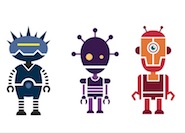Robotics in Education
Robotics is the current trend. Maybe there is too much emphasis on it. Moreover, the meanings associated with it are different, as shown by the meeting promoted by both Italian Society for Research on Media Education (SIREM) and Elearning, Media, Education and Moodlemot (EMEM) Italia 2016, as well as the more recent conference “Giocare a pensare. Metodi e tecnologie per l’uso didattico dei robot/Playing and thinking. Methods and technologies for the educational use of robots”, organised by Edoardo Datteri and Luisa Zecca of the University of Milan-Bicocca in May 2017. The activities focussed on this topic are numerous, often fostered by the National Plan for Digital School, where robotics has a significant space. The proposals are “didactical scenarios built around educational robotics, logic and computational thinking, manual and digital artefacts, serious play and storytelling” in “the perspective of building transversal learning” (Plan for digital school, 50). The request is to introduce “the methodology of Problem Posing and Solving in the teaching of Maths (…) and elements of educational robotics in the curricula of high school” (ivi, 75). Finally the prescriptive recommendation: “all students should be offered paths on making educational robotics, Internet of Things” (ivi, 78). As we can see, robotics is being connected not only to problem-posing and inter-disciplinarity but also to the Internet of Things.
Research on Education and Media
Theoretical vocabularies and styles of explanation of robot behaviours in children
How do children describe and explain the behaviour of robotic systems? In this paper, some distinctions between different types of explanations, drawing from the philosophy of science literature, are proposed and exemplified by reference to an activity in which primary school children are asked to describe and explain the behaviour of a pre-programmed Braitenberg-like vehicle. The proposed distinctions are also discussed against other studies drawn from the related scientific literature. A qualitative study has provided insights to further refine the analysis described here, through the introduction of other sub-categories of explanation of robotic behaviours.








